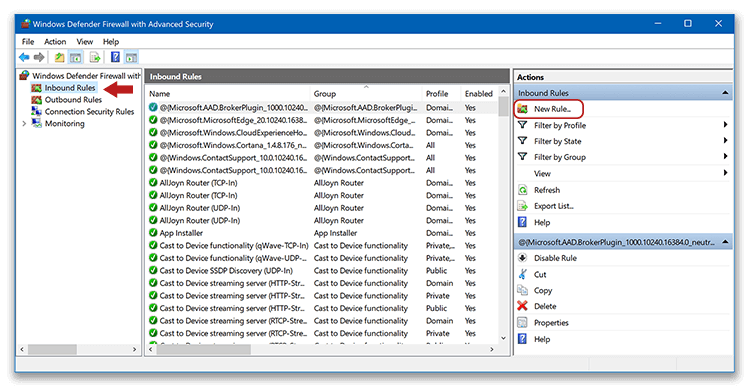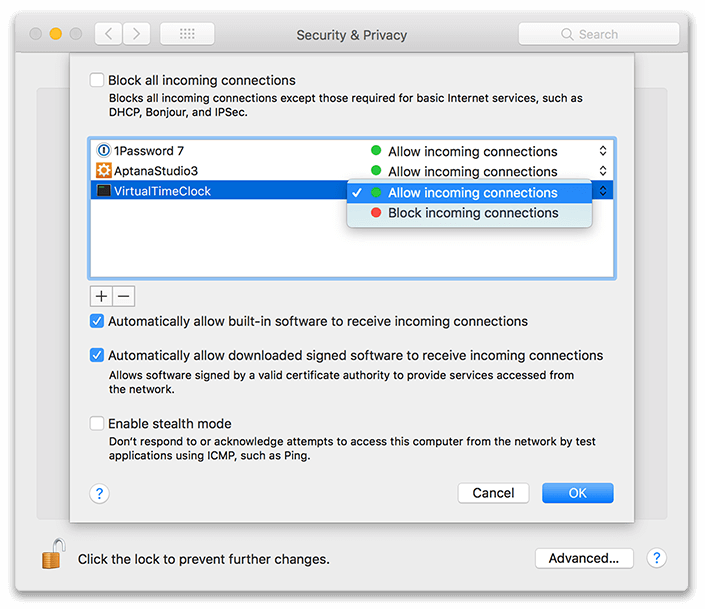Virtual TimeClock Knowledge Base
Creating Firewall & Antivirus Port Exceptions
Firewall and antivirus software help secure your computer from malicious programs or viruses that can try to access your computer without your knowledge. A computer with a firewall enabled will often block Virtual TimeClock, preventing the TimeClock Server computer from communicating with client computers. Creating port exceptions will allow incoming TimeClock client connections to communicate with the TimeClock Server. Keep reading to find out how to create exceptions for Windows and macOS computers as well as information about antivirus programs.
Note: The following rules only need to be created on the TimeClock Server computer, not on the individual time clock client computers.
Windows and macOS Firewall Port Exceptions
Windows computers have a built-in firewall that is turned on by default. This means you will need to add firewall exceptions when setting up the TimeClock Server for the first time. Follow the guides below for your operating system.
Note: Windows Updates from Microsoft can occasionally delete all firewall exceptions which will interrupt TimeClock communication. In this case, you must add these firewall exceptions back to your TimeClock Server computer.
Windows 10
- Click the Windows Start button and type "firewall" - select Windows Defender Firewall.
- In the left pane, select Advanced Settings. Enter your admin password if prompted.
- In the left pane, click Inbound Rules and then choose New Rule from the right pane.

- Select Port and click Next.
- Select TCP then Specific local ports, enter 56777 and click Next.
- Select Allow the connection and click on Next.
- Leave all profiles checked on the next screen and click Next.
- Enter VTC TCP as the rule name and click Finish.
- Repeat steps 4-9 for UDP:
- Port type = UDP
- Specific Local Port = 56778
- Rule name = VTC UDP
Windows 7 & 8
- Go to the Start menu and choose Control Panel.
- Click System and Security then Windows Firewall.
- Click Advanced Settings in the left pane.
- Click Inbound Rules in the left pane and then New Rule in the right pane.
- The New Inbound Rule Wizard will appear.
- Select Port for the type of rule and click Next.
- Select TCP then Specific local ports and enter 56777 and click Next.
- Select the Allow the connection and click Next.
- Leave all profiles checked on the next screen and click Next.
- Enter “VTC TCP” as the rule name and click Finish
- Repeat steps 5-10 for UDP:
- Port type = UDP
- Specific Local Port = 56778
- Rule name = VTC UDP
Windows Vista & XP
- Go to the Start menu and click Control Panel.
- Double-click Windows Firewall.
- Vista only: Click Allow a program through Windows Firewall.
- On the Exceptions tab, click Add Port.
- Enter “VTC TCP” in the Name box.
- Enter 56777 in the Port number box.
- Select TCP for the network protocol and click OK.
- Repeat steps 4-7 for the UDP port:
- Port type = UDP
- Specific Local Port = 56778
- Rule name = VTC UDP
Mac Firewall Exceptions
By default, macOS computers allow signed software (like Virtual TimeClock) to receive incoming connections and have a firewall that is turned off by default, so the need for exception rules is less common. You should not experience issues with your firewall unless this option has been disabled or incoming connections have been manually blocked. To ensure your firewall has been properly configured:
- Select System Preferences from the Apple menu.
- Click the Security or Security & Privacy icon.
- Select the Firewall tab. If this window says Firewall: Off do not follow steps 4-9.
- To make changes, click the lock icon and enter an administrator name and password.
- Click the Firewall Options button.
- Ensure that the option to Automatically allow downloaded signed software to receive incoming connections in enabled.

- Verify that the TimeClock Server has not been manually blocked in the connections list. If the Server has been blocked it will show on the list with a note that incoming connections have been blocked.
- To unblock the TimeClock Server click on Block incoming connections and changed the setting to Allow incoming connections. Click OK to finish.
Antivirus Exception Rules
If your computer has a third party antivirus program, you may need to create an exception rule in the antivirus software for Virtual TimeClock to operate correctly. Examples of common antivirus programs that you may have are McAfee, Avast, AVG, Norton, Kaspersky and many more. These programs are usually in addition to the built-in Windows or Mac firewalls.
Since every antivirus program is different, you will need to find out how to create exceptions for your specific software. Please consult your antivirus user manual or search the internet to find out how to create exception rules for your specific antivirus program (e.g. “Symantec exception rules”). As a general rule, look under the Settings menu for an option like Program Permissions, Exceptions, Exclusions or Rules.